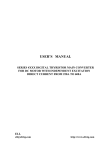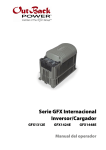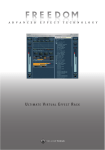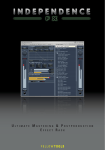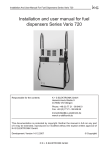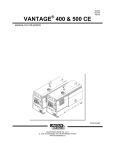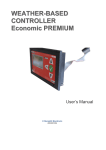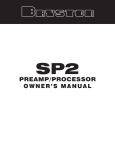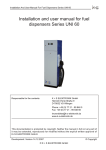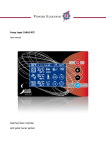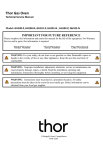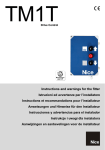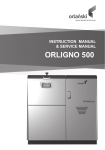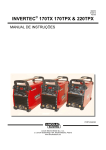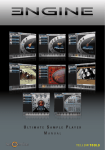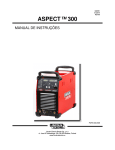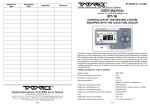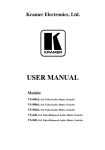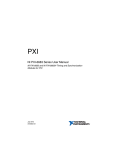Download MultiFun control system
Transcript
MultiFun control system Type MULTIFUN Software: SAS_GRO_2_2014_11_20 ©Recalart Electronic List of contents Introduction............................................................................................................................................................. 5 Warning........................................................................................................................................................... 5 INSTALLATION ..................................................................................................................................................... 6 Warning........................................................................................................................................................... 6 CONNECTION ....................................................................................................................................................... 6 Hazard ............................................................................................................................................................. 6 PRECAUTIONS...................................................................................................................................................... 7 DISPOSING USED EQUIPMENT ............................................................................................................................ 8 Description of the device ......................................................................................................................................... 9 The main run-time module .................................................................................................................................. 9 Description of outputs ................................................................................................................................... 10 Description of measuring inputs ................................................................................................................... 10 Connection diagrams .................................................................................................................................... 12 Installation diagrams .................................................................................................................................... 12 Installation diagram No. 2 ............................................................................................................................ 13 Control panel ..................................................................................................................................................... 15 Description of main elements........................................................................................................................ 15 Main menu .................................................................................................................................................... 15 User menu ............................................................................................................................................................. 16 Temperatures .................................................................................................................................................... 17 Heating temperature..................................................................................................................................... 17 H.W. temperature ......................................................................................................................................... 17 SYMBOLS ........................................................................................................................................................... 17 Turning on the boiler ..................................................................................................................................... 17 Fan power - burning ...................................................................................................................................... 18 The feeder standby time – burning ............................................................................................................... 18 Fan power – sustaining ................................................................................................................................. 18 The feeder standby time – sustaining ........................................................................................................... 18 Set the time ................................................................................................................................................... 18 History and statistics ..................................................................................................................................... 18 SUMMER/WINTER modes ............................................................................................................................. 19 Manual mode .................................................................................................................................................... 20 Manual control .............................................................................................................................................. 20 Sensor test ..................................................................................................................................................... 20 2 Advanced ........................................................................................................................................................... 20 Boiler ............................................................................................................................................................. 20 C.H. 1 and 2 circuit ........................................................................................................................................ 24 Central circuit control parameters .................................................................................................................... 25 Manual .................................................................................................................................................................. 25 Thermostat ............................................................................................................................................................ 25 Thermostat+external sensor. ................................................................................................................................ 25 Room sensor+external sensor ............................................................................................................................... 25 H.W. CIRCUIT ................................................................................................................................................. 29 Clock .............................................................................................................................................................. 32 Other ............................................................................................................................................................. 32 Service menu ......................................................................................................................................................... 33 Boiler ................................................................................................................................................................. 33 Minimum temperature .................................................................................................................................. 33 Maximum temperature ................................................................................................................................. 33 Critical temperature of the boiler .................................................................................................................. 33 Return protection temperature ..................................................................................................................... 33 Additional temperature of the boiler ............................................................................................................ 34 Protection of the dispenser ........................................................................................................................... 34 Boiler power .................................................................................................................................................. 34 Feeder capacity ............................................................................................................................................. 34 C.H. circuit No. 1 and 2 ...................................................................................................................................... 34 Mixer ............................................................................................................................................................. 34 Circuit control ................................................................................................................................................ 35 Pump turning on temperature ...................................................................................................................... 36 Circuit priority................................................................................................................................................ 36 H.W. circuit ........................................................................................................................................................ 36 H.W. priority .................................................................................................................................................. 36 Circulating pump ........................................................................................................................................... 37 H.W. rundown during summer ...................................................................................................................... 37 Pump starting temperature .......................................................................................................................... 37 Default settings ................................................................................................................................................. 37 Signalling emergency situations............................................................................................................................ 38 Alarms ............................................................................................................................................................... 38 Warnings ........................................................................................................................................................... 38 THE GUARANTEE AND COMPLAINTS ..................................................................................................................... 39 3 Guarantee Card ..................................................................................................................................................... 41 4 Introduction The following instruction manual was written for all users who will connect, install, operate and conduct routine maintenance of Multifun control system regulators. The instruction manual includes descriptions of installation, wiring, functions and operating procedures. It should be kept near the workplace area while operating the regulator. The information contained therein must be always followed. Warning Should any fault occur or accessories are missing, please contact your local dealer or sales office at RECALART ELECTRONIC. MULTIFUN CONTROL SYSTEM regulators are designed for mounting in control cabinets or similar installations in a way that prevents their contact with electrical cable thimbles. Do not remove the regulator from the housing. Your hand or other conductive body must not be found in the housing. This could result in a serious injury or death due to electrical shock. To avoid damage to the connected equipment or the MULTIFUN CONTROL SYSTEM regulators, prior to using the device take any safety measures necessary, such as installing a fuse, overheat protection device, etc. Should an accident caused by using the product without observing these safety measures occur, the warranty will be void. The power switch in the external circuit of the regulator turns off power. The switch needs to be installed on the device in a position that allows for ease of use. There should be a message that the switch turns off power. Use a switch which meets IEC947 standards. The device does not have a built-in fuse therefore a fuse must be installed in the power circuit when connected to a phase terminal. The fuse should be placed between the power switch and the device and mounted on the "L" side of the phase terminal. Fuse rated values/characteristics: 250 VAC 6.3A quick. Use only a fuse complying with IEC 127 standards. Voltage/current values of load to connect to the output terminal and the alarm terminal should be placed within the range of the rated values. Otherwise, the temperature will increase and reduce the regulator's life causing problems in the operation of the device. Voltage/current other than specified in the input specifications should not be attached to the input terminal. This may shorten the instrument's life and cause operation problems. For the voltage or current input, the input terminal should be connected to a device that meets IEC1010 requirements. The device may have vent holes to carry off heat. Metal elements or other that can damage the device or cause fire must not get inside the holes. The vent hole must not be blocked nor contaminated. A temperature increase or insulation failure may shorten the instrument's life or damage it. Moreover, these situations may be a direct cause of a fire. Information about spaces that separate the regulators in the control cabinet in are described in chapter en."Internal dimensions and a panel cut-out" of the service documentation. It should be noted that repeated tolerance tests for voltage, disturbance, surge, etc., may deteriorate the instrument's operation. 5 Changes made to the device or its improper use is prohibited. INSTALLATION The regulator should not be used in the following places: • In environments including flammable gas, corrosive gas, oil mist or particles that can deteriorate the electrical insulation. • In an atmosphere at a temperature below 0°C or above 55°C and relative humidity above 90%RH or below the dew point. • In an environment with high vibration or shock levels. • In locations exposed to high electromagnetic interference. • In areas exposed to direct sunlight. • In an environment at a height of over 2000 meters above sea level • Outdoors. The aforementioned places can cause malfunctions, fire or damage to the device. Warning For safety reasons, do not remove the regulator body from the housing. If it is necessary to remove it from the housing to replace a part or conduct repairs, please contact your nearest sales representative. CONNECTION Assembly procedures should be carried out only by persons qualified in the subject of electric device installation. Przywykonywaniupodłączeniaregulatoranależyzwrócidszczególnąuwagęnanastępującewarunki: Hazard Electrical wiring assembly- or disassembly-connected installation works can be carried out only after switching off the power supply of the device. Cable thimbles and other live elements of the device must not be touched. All connections made must be compatible with the electrical wiring diagram as well as national or local requirements for electrical connections. 1. When carrying out the assembly of the regulator's electrical installation, the instructions of this manual must be carefully followed. 2. Copper cable connections should be adjusted to operate at temperatures up to 75°C. 3. For the thermocouple input, a compensating lead which corresponds to the type of the thermocouple needs to be used. 4. The input signal cable should not be placed in the same conduit as the AC power cable. 5. Using a suitable cable (a twisted pair) for input signals is effective and protects against interference caused by electromagnetic induction. 6. To power the regulator, use a cable the parameters of which are the same or higher than those for the cable insulated with 600V vinyl with a cross-section of 1 mm2 or bigger. 6 7. Tighten the terminal screws to a torque of 1.0 Nm. 8. If the device proves sensitive to power disturbances, a disturbance eliminator should be used to prevent malfunctions. The disturbance eliminator should be mounted on a grounded panel and cable connections between the output of the disturbance eliminator and regulator power line terminals should be as short as possible. PRECAUTIONS • The attached instruction manual has to be carefully read prior to using the device. • The instruction manual needs to be kept and referred to when necessary. • All rules and warnings in the instruction manual have to be followed. • The device must not be damaged in any way. If in doubt, the appliance cannot be used and your supplier must be contacted. • If there are any doubts concerning a safe operation of the equipment, please contact your supplier. • Special attention should be paid to all warning labels on the box and the housing. • The device must be used in accordance with its intended purpose. • This is not a toy. Children are not allowed to play with it. • Children are not allowed to play with any part of the packaging. • Keep small parts, such as screws and pins, out of reach of children. These elements can be provided along with the device and if swallowed can cause death by suffocation. • Do not make any mechanical or electrical changes to the device. Such changes may result in improper operation of the unit which does not conform to standards and affect it negatively. • No elements should be inserted into the device through slots (e.g. vent slots). This may cause a short circuit, electric shock, fire or damage to the device. • Do not allow water, moisture and dust inside the device. This may cause a short circuit, electric shock, fire or damage to the device. • Proper ventilation of the equipment must be ensured. Do not cover or block the ventilation holes to ensure free air flow. • The unit must be installed inside premises unless it is adjusted to outdoor use. • The unit must not be exposed to shock and vibration. • When connecting the device, the parameters of the electrical supply network must meet the operation range of the unit. • To avoid an electrical shock, the unit should be connected to a grounded wall outlet. The grounding must be made by an authorized electrician. • When connecting the device, make sure that the electrical circuit will not be overloaded. Avoid connecting the device to one circuit with motors and other devices that could cause interference (e.g. washing machines, refrigerators, ...). • Prior to connecting any cables and wires to the device, the power supply must be disconnected. • To disconnect the unit from the power supply, pull out the plug from the outlet. The device should be disconnected when left unused for a long time. • Protect the power cord against damage. • All connections must be compatible with the electrical wiring diagram and national or local electrical requirements. 7 • This unit does not contain parts that can be replaced by the user. All service operations except for cleaning, fuse replacement (when disconnected) and function setting should be made by qualified service personnel. • Prior to carrying out any maintenance work, the unit must be disconnected from the power circuit. • The housing cannot be cleaned with gasoline, solvents or other chemicals that may damage it. We recommend using a soft cloth. • If the AC power cord is damaged, do not use it. A damaged cable must be exchanged for a new one with the same specifications. DISPOSING USED EQUIPMENT The electronic unit is partly made of recyclable materials. For this reason, when used up it must be subject to recycling or returned to the manufacturer. The equipment must not be disposed of along with other domestic waste. SAFETY OF USE The following instruction manual should be given to a final user of the device. 8 Description of the device Multifun control system regulator is a modern multiprocessor control system for heating equipment. The basic version of the system consists of a control panel and a main run-time module. These devices are connected via a LAN cable and an RJ45 type connector. Additional modules can also be connected with the use of this cable. Data transfer is carried out in RS485 standard. A modified MODBUS protocol ensures a correct data exchange. The main run-time module For the basic operation of the device, boiler sensors have to be connected to the run-time module, otherwise the boiler will not work properly: Boiler feed temperature sensor [BOILER FEED] Feeder temperature sensor [FEEDER] For successful running of other functions of the controller, appropriate sensors have to be connected to the run-time module: Fan hall effect sensor (C13)* - recommended when using a fan equipped with a revolution number sensor. Hot water temperature sensor [HW] – for water heating. Central Heating temperature sensor 1 [CH] – required to control a mixing valve Central Heating temperature sensor 2 [C.O.2] Return temperature sensor of the heating medium [Boiler Return] – protects against return of cold water to the boiler. The sensor is necessary to work with the mixing valve or the circulating pump. External temperature sensor [External] – required for an active weather function Room 1 temperature sensor [Room1] - an internal temperature sensor required for circuit control type: room sensor + external sensor Room 2 temperature sensor [Room2] - an internal temperature sensor required for circuit control type: room sensor + external sensor 9 Description of outputs Description DEVICE Dispenser feeder (P) Fuel feeding screw motor - max. 1,2(0,6)A 230V~ Fan (W) Blower motor - max. 1,2(0,6)A 230V~ Heater (G) C.H.1 (P1) pump Heater - max. 4(2)A 230V~ (inductive loads require an additional externally installed RC suppression system) Central Heating circuit pump 1 – max. 1,2(0,6)A 230V~ C.H.2 (P4) pump Central Heating circuit pump 2 – max. 1,2(0,6)A 230V~ H.W.(P2) pump H.W.(P3) circulating pump Closed mixer 1 (M1) HW dispenser pump – max. 1,2 (0,6) A 230V~. The HW pump is turned on, if water heating is required HW circulating pump – max. 1,2 (0,6) A 230V~. The HW circulating pump is turned on when the twenty-four hour program on the HW is turned on. Mixing valve actuator (closing) – max. 1,2 (0,6) A 230V~ Open mixer 1 (M1) Mixing valve actuator (opening) – max. 1,2 (0,6) A 230V~ Closed mixer 2 (M2) Mixing valve actuator (closing) – max. 1,2 (0,6) A 230V~ Open mixer 2 (M2) Mixing valve actuator (opening) – max. 1,2 (0,6) A 230V~ Emergency pump (P5) Emergency pump- max. 1,2 (0,6) A 230V Function: circulating pump. Grate – max. 1,2(0,6)A 230V Grate (R) Description of measuring inputs Description BOILER (C1) Feeder (C2) H.W.(C3) FEED sensor C.H. 1 (C4) Room 1 sensor 1 (C5) Room 2 sensor (C7)* External (C6) sensor BOILER RETURN (C8) C.H.2 (C9) SENSOR DESCRIPTION A measuring input for the boiler temperature sensor; the sensor is fitted in the boiler measuring hole. The sensor is required for proper operation of the boiler. A measuring input for the feeder temperature sensor; the sensor is required for proper operation of the boiler. A measuring sensor input for hot water; the sensor is fitted in a measuring hole of the hot water exchanger. Connect only, if an actuator is fitted in the mixer 1 of CH circuit - the temperature sensor is fitted downwards the mixing valve, the sensor should be fitted on the pipe downwards the mixing valve using a clamping ring and insulation. Ensure proper contact between the sensor and the pipe. The sensor is available in an additional set. The measuring input function is configured in the service by a fitter as: a) a room sensor – measuring temperature in a room b) thermostat input with make contacts The measuring input function is configured in the service by a fitter as: a) a room sensor – measuring temperature in a room b) thermostat input with make contacts The measuring input of an external sensor. An external sensor has to be connected for weather control of the central heating circuit: an external sensor + thermostat and an external sensor + a room sensor A temperature sensor on the return position from the heating system; the sensor is to be fitted on the return pipe on the boiler or in a special boiler measuring hole or a pipe. Ensure proper contact between the sensor and the pipe! The sensor is available in an additional set. Connect only, if an actuator is fitted in the mixer 2 of CH circuit - the temperature sensor 10 Exhaust gas sensor (C10) Smelt sensor (C11) Fan hall effect sensor (C12) Grate hall effect sensor (C13) is fitted downwards the mixing valve, the sensor should be fitted on the pipe downwards the mixing valve using a clamping ring and insulation. Ensure proper contact between the sensor and the pipe. The sensor is available in an additional set. An input used for exhaust gas measuring in the chimney. Smelt temperature measuring. The controller cooperates with fans with a HALL inbuilt revolution sensor (option – depends on a blower type used) Additional input to an additional hall effect sensor. 11 Connection diagrams P- dispenser feeder, P1- C.H.1 pump, P2- H.W. dispenser pump, P3 – H.W. circulating pump, P4- C.H.2 pump, P5emergency pump, M1- mixing valve actuator 1, M2- mixing valve actuator 2, C1- boiler feed sensor, C2- feeder sensor, C3- H.W. sensor, C4- C.H.1 sensor, , C5- room sensor, C6- external sensor, C7- room sensor 2, C8- boiler return sensor, C9- C.H.2 sensor (serves as a floor sensor in circulating circuits 1), C10- exhaust gas sensor, C11smelt sensor, C12- fan hall effect sensor, C13- grate hall effect sensor Figure 1.The diagram of electrical connections for the run-time module Installation diagrams 12 C1-boiler feed sensor, C2 – feeder sensor, C3-HW sensor, C4-CH sensor, C5-room sensor, C6-external sensor, C8boiler return sensor, P1-CH pump, P2-HW dispenser charging pump, P3-HW circulating pump, M1-mixing valve actuator. Figure 2.Hydraulic installation diagram Installation diagram No. 2 13 C1-boiler feed sensor, C2 – feeder sensor, C3-HW sensor, C4-CH sensor, C5-room sensor, C6-external sensor, C7-room sensor, C8-boiler return sensor, P-dispenser feeder, P1-CH pump, P2-HW dispenser charging pump, P3-HW circulating pump, P4- C.H. pump, P5-circulating pump, M1-mixing valve actuator, M2-mixing valve actuator. Figure 3.Hydraulic installation diagram 14 Control panel Description of main elements 1- Signalling LED 2- Knob with a button used to enter the menu and select parameters. 3- Menu exit button / Circuit selection button 4- info button – enters the info or help screen 5- Start screen information field: S.type - software version S.ver: - display module software number P: - boiler power Main menu Description of main menu Main menu 1- Fan power indicator Note: only for active PID algorithm 2- Dispenser feeder operating conditions 3- Fan operating conditions 4- Measured smelt temperature (note: activate PID algorithm and autofuel functions) 5- Measured boiler temperature 6- Calculated boiler temperature 7- Measured exhaust gas temperature 8- Circuit selection 15 A- C.H. circuit 10- C.H. pump operating conditions 11- Operating conditions – opening mixing valve 12- Operating conditions – closing mixing valve 13- Mixing valve turned on 14- Mixer turned off 15- Measured temperature on C.H. sensor 16- Controller in SUMMER mode (C.H. circuit turned off) 17- Shorted thermostat (for circuit No. 2 and 3) 18- Heating conditions in C.H. circuit. 19- Temperature decrease in C.H. circuit (for circuit No. 1 and 4) 35- Circuit turned off B- H.W. circuit 20- H.W. circulating pump operating conditions 21- H.W. dispenser charging pump operating conditions. 22- Circulating pump turned off 23- H.W circuit turned off (H.W. sensor not connected) 24- Measured hot water temperature C- Info window 25- Measured external temperature (displayed for C.H. circuit No. 3 and 4) 26- Weekday displayed (e.g.: 1-Monday, 7 - Sunday) 27- Clock 28- Measured room temperature (displayed for C.H. circuit No. 4) D- Boiler operation type 29- Burning 30- Sustaining E- Emergency pump operation 32- BYPASS pump operating conditions F- Boiler screen 34- Emergency state on the boiler (if there are no emergency states, a boiler icon will be displayed) User menu 16 Temperatures Heating temperature Heating temperature set depends on the selected central heating circuit type: For weather mode (with an external sensor) – temperature is set in the room (control range from 5 to 30 C) For configuration without an external sensor ( configured by the Service) the control range for this parameter equals the boiler temperature. C.H.1 temperature Setting temperature, which is to maintain in C.H. circuit 1. Adjust heating temperature parameters to heating type (floor, radiator heating) C.H.2 temperature Setting temperature, which is to maintain in C.H. circuit 2. Adjust heating temperature parameters to heating type (floor, radiator heating) H.W. temperature Set hot water temperature in the dispenser. SYMBOLS the most frequently used functions of the regulator are put in the menu > Turning on the boiler Fan operation mode Fan power Feeder operation mode The fan power is set with the use of a knob. - inactive device 17 Symbols - active device Note! The boiler turning on process may be stopped automatically for the following parameters: Stopping temperature or Turning on time in the Menu - advanced > Boiler >Turning on The user may stop turning on by pressing the return button Note! The turning on function may not be actuated, if the Boiler temperature exceeds the boiler maximum temperature (see Service parameters). manually Fan power - burning The parameter is used for setting the fan power during burning. If there is too much soot in the boiler, blowing should be increased. It is recommended to decrease blowing, if fuel burns too much. Note*: In case of active PID algorithm, the fan power during burning is set automatically by the controller. The use may increase or decrease blowing using the following parameter: Burning-blowing adjustment. The feeder standby time – burning The feeder standby time during burning. Note*: In case of active PID algorithm, the feeder standby time during burning is set automatically. The user may shorten or extend the feeder standby time using the following parameter: Burning-fuel adjustment. Fan power – sustaining The parameter is used for setting the fan power during sustaining. If there is too much soot in the boiler, blowing should be increased. It is recommended to decrease blowing, if fuel burns too much. Note*: In case of active PID algorithm, the fan power during sustaining is set automatically by the controller. The use may increase or decrease blowing using the following parameter: Sustaining-blowing adjustment. The feeder standby time – sustaining The feeder standby time during sustaining. Note*: In case of active PID algorithm, the feeder standby time during sustaining is set automatically. The user may shorten or extend the feeder standby time using the following parameter: Burning-fuel adjustment. Set the time Setting time in the controller. Note – a full date is set in the menu –Advanced/Clock. History and statistics 1. Stages of setting browsing history and statistics 18 1- External temperature axis 2- Date 3- Hours 4- Next 5- Data displayed on charts, e.g.: - boiler temperature chart ON - boiler temperature chart OFF 6- Go to selection of data from the chart: - active chart browsing. - active data selection 7- Temperature axis for the remaining data 2. Go to the statistics marking screen 8- Time marker 9- Marked data area – Start 1 10- Marked data area – End 1 10- Marked data area – Start 2 12- Marked data area – End 2 3. After selecting two areas, go to statistics 13- Temperatures 14- Burner – fuel consumption 15- amount burned in kg/h 16- first range of statistics 17- second range of statistics min – minimum temperature avg – average temperature max – maximum temperature The history of operation of the installation is recorded every minute. The controller memory stores as maximum the history from the last 10 days. Using the menu seen on the right side of the screen, the user may hide unnecessary charts, which increases legibility of information displayed on the screen. After marking the range of data, the regulator calculates an average value or a given time. It is possible to compare 2 different time sections (e.g. boiler room operation on Monday and Tuesday) in order to analyse the influence of the regulator settings on fuel consumption. The controller provides complete fuel consumption in a given period of time and average burning per hour. Additional data (operation history) may be stored on a SD card and analysed on a PC. SUMMER/WINTER modes 19 Select the operating mode. This option selects chooses the operating mode, but it is possible to choose the AUTO (more in SUMMER/WINTER/AUTO mode). Note: in case of a program for several heating circuits, the parameter is not visible Manual mode The manual control mode is used to check devices and sensors connected to the regulator. Manual control This allows forcing operation of particular devices. The knob is used to select a device. The operation state of the device is changed by pressing the knob. The v30.07 software version (and higher) includes information about the number of revolutions of a blower per minute if the Hall effect sensor generator is working and connected. If the Hall effect sensor is not connected or fails, red lines appear instead of information about the number of revolutions per minute. Sensor test The sensor test allows for reading current temperatures on sensors connected to the boiler. Advanced Boiler Burning Fan power The parameter is used for setting the fan power during burning. If there is too much soot in the boiler, blowing should be increased. It is recommended to decrease blowing, if fuel burns too much. Note*: In case of active PID algorithm, the fan power during sustaining is set automatically by the controller. The use may increase or decrease blowing using the following parameter. Burning-blowing adjustment. The feeder operation time The fuel feeding time during burning. Note*: In case of active PID algorithm, the fuel feeding time burning is set automatically by the controller: The feeder standby time The feeder standby time during burning. Note*: In case of active PID algorithm, the feeder standby time during burning is set automatically. The user may shorten or extend the feeder standby time using the following parameter Burning-fuel adjustment. Sustaining Fan power The parameter is used for setting the fan power during sustaining. If there is too much soot in the boiler, blowing should be increased. It is recommended to decrease blowing, if fuel burns too much. 20 Note*: In case of active PID algorithm, the fan power during burning is set automatically by the controller. The use may increase or decrease blowing using the following parameter: Blowing adjustment. The feeder operation time The fuel feeding time during sustaining. Note*: In case of active PID algorithm, the fuel feeding time burning is set automatically by the controller. The feeder standby time The feeder standby time during sustaining. Note*: In case of active PID algorithm, the feeder standby time during burning is set automatically. The user may shorten or extend the feeder standby time using the following parameter Burning-fuel adjustment. Burning type Burning type selection: Automatic – the fan and feeder operate according to parameters set in the controller. Feeder interlock – the controller will turn off the feeder only. Feeder and fan interlock – the controller will turn off the fan and feeder PID PID activation PID function is each time modified for a type series of boilers and operates properly with such boilers only. Most frequently the manufacturer’s original software ensured the required compatibility. It is very important to check the boiler power displayed by the controller (advanced – other – info relating to the controller), as it has to comply with the boiler power shown on the rating plate. The user can use the following parameters: blow adjustment, air adjustment, exhaust gas temperature decrease, which allow for precise adjustment of PID in case of a non-standard chimney draft and low calorific fuel purchased. Additionally, a function of autofuel may be used (a smelt sensor has to be connected). Multifun controller has 2 PID modes: standard PID turbo PID Note: PID function is active only, if settings are stored. PID power The parameter specifies maximum boiler power available for PID algorithm. The power limitation should be used for sintering fuels and fuels of poor quality. Minimum power limits the quantity of air and fuel and, at the same time, fuel sintering. The boiler operates with lower power (approx. 50% of rating power). Setting the parameter as “average power” allows for using approx. 75% of the boiler rating power. Note: The parameter is available, if PID algorithm is turned on. PID TURBO PID Turbo mode – dynamic increase of the boiler temperature – much quicker heating than in PID standard mode Power increment Power increment – limits the change speed in PID turbo mode. The parameter specifies maximum change of power expressed in % per 1 minute. We recommend setting 5% value for weak fuel. In this case, the furnace power increment from 1 to 100 will take 20 minutes. 21 Power drop Limitation of power drop speed for PID turbo. We recommend 10-20% for good coal afterburning. Note: The parameter is available for PID algorithm turned off. Fuel shortage detection Turning on a fuel shortage detector Turning on a fuel shortage detector. The function is activated below the boiler protection temperature. During the set time (fuel shortage detection time), the regulator waits for increase of exhaust gas temperature and boiler temperature. If the temperature does not rise, the regulator turns off all devices (including pumps) and displays an error – FUEL SHORTAGE. Fuel shortage detection time Setting the fuel shortage detection time. Firing up Firing up end temperature The regulator will turn off firing up functions, if the boiler temperature rises by the value set. The firing up function may also be turned off upon elapse of the time set (see below: “firing up time”). The controller will go to normal work, i.e. burning and the screen will go back to the main menu automatically. Firing up time The parameter specifies the period of time, for which the firing up function may be turned on. After setting of the time, the controller will go back to the main menu. Hysteresis The parameter is of importance only for operation with the PID option turned on. The burning stage will be changed to the sustaining stage, when the temperature on the boiler rises to ½ of hysteresis above the value set. After cooling of the boiler, when its temperature drops below the set value by ½ of hysteresis, the controller will go back to the burning stage. Limitation of exhaust gas temperature * Higher than set temperature of exhaust gas will cause reduction of the boiler power. It will cause decrease of blowing and quantity of fuel fed. The function will work, if a PT1000 exhaust gas sensor is mounted. The parameter operates as additional limitation of the boiler power and is to reduce chimney loses. It operates regardless of the above-mentioned PID POWER parameter. Note!: The function operates in an active PID algorithm mode Smelt sensor The use of feedback such as fuel temperature in the afterburning area in the control process, allows for automatic selection of fuel for eco-pea coal with its calorific value ranging from 19MJ/kg to 28MJ/kg. The solution is very effective in practice. Tests results show fully automatic operation in 95 % of all cases. The regulator adjusts fuel doses automatically in order to obtain optimum smelt temperature in the entire range of 22 the boiler operation. Our solution allows for modulation of the boiler power within the range of 30-100% of rating power ( PID) an, at the same time, maintaining the proper fuel level in the furnace. Smelt sensor (ON/OFF) Turning on the smelt sensor function. The controller modifies the interval time between subsequent fuel doses in the burning stage automatically. The function monitors the smelt sensor temperature on an on-going basis and, on the basis of the temperature, it decreases or increases intervals between fuel doses. The effects of the controller operation with a smelt sensor option turned on are visible after several hours of work. Frequent changes such as air and fuel adjustments by the user are not recommended. They may cause errors in operation of the controller, which are displayed as inappropriate afterburning of fuel etc. 23 Smelt temperature – adjustment Increase of the parameter value leads to increase of the fuel level and increase of temperature in the combustion chamber. Decrease of the parameter value leads to decrease of the fuel level. It is recommended to set negative adjustment in case of fuel of poor quality and fuel, for which it takes long to fire up (additionally in this case it is worth limiting power with the use of PID parameter, maximum range of operation of PID function to average power or even minimum power). Low smelt temperature ( e.g. 100°C) fuel feeding is increased gradually Optimum smelt temperature (e.g. 500°C) fuel feeding is not changed Too high smelt temperature (e.g. 760°C) fuel feeding is gradually limited until smelt optimum temperature is obtained C.H. 1 and 2 circuit Multifun controller may control two heating circuits without any additional equipment. For more heating circuits, the controller should be additionally equipped with a Sub-menu module “C.H. Circuit” adjusted to Circuit control option selected by the fitter. Setting parameters for more C.H. circuits is realised identically. 24 Central circuit control parameters Manual Thermostat User parameters: >Advanced>C.H. circuit Heating temperature Lowered heating temperature SUMMER/WINTER mode C.H. program Turning off the circuit User parameters: >Advanced>C.H. circuit Lowered heating temperature SUMMER/WINTER mode Turning off the circuit SUMMER/WINTER Wyłączanie obiegu Thermostat+external sensor. Room sensor+external sensor User parameters: >Advanced>C.H. circuit Heating temperature Lowered heating temperature SUMMER/WINTER/AUTO mode Weather characteristics Auto temp. SUMMER/WINTER Turning off the circuit Required: C6 external sensor User parameters: >Advanced>C.H. circuit Heating temperature Lowered heating temperature SUMMER/WINTER/AUTO mode Weather characteristics Room sensor adjustment Room sensor calibration Auto temp. SUMMER/WINTER C.H. program Turning off the circuit Required: C5 room sensor (or C7,Cx, C6 external sensor) 25 Heating temperature The heating temperature set depends on a selected central heating circuit type. In weather mode (with an external sensor) temperature is set in a room (ranging from 5 to 30 C) . For configuration without an external sensor ( configured by the Service) the control range for this parameter equals the Central Heating temperature. C.H. pump1 Note: C.H. pump will be turned on in the anti-freeze mode, when the external temperature is below -2°and the boiler temperature drops below +10°. Pump operation mode The parameter determines the C.H. pump operation in a simple system, i.e. without a mixing valve with an actuator. If the Service enables the operation mode with a mixing valve (SERVICE menu), the pump will operate uninterruptedly in the winter mode - the settings of the parameter discussed below are not relevant. Available options include: 1. 100% interlock - a signal from the room thermostat or inactive heating program interlocks the pump the pump is not operating 2. Modulated operation – a signal from the room thermostat or inactive heating program activates intermittent operation (see setting below) 3. 0% interlock – the room thermostat or inactive heating program do not affect C.H. pump operation. The setting is recommended in case of extensive systems, where modulated operation of the pump cannot heat distant radiators Modulated operation – operation time The objective of modulated operation of the C.H. pump is to lower radiator temperature based on information from the room thermostat or heating program. A short-circuit in measuring input of the room sensor is a signal for regulator to use one of the three operation modes of the C.H. pump. The discussed parameter has influence upon the operation of the pump in the "MODULATED OPERATION " mode. This parameter determines the pump operation time (set from 1 minute to 60 minutes). After the operation time runs out, the regulator interlocks the pump for standby time – see the description below. Modulated operation – standby time After the operation time, the pump stops for the time set. The setting range is from 10 to 60 minutes. Heating temperature decrease Heating temperature decrease is a parameter set according to a selected "circuit control" option (set by the Service). For manual control, the temperature decrease of the C.H. system is set in %. The temperature decrease is set in the C.H. Program option (see the description below). 1 This option is available only for the following service setting :”Circuit control” in: Thermostat, Thermostat + external sensor and Internal sensor + internal sensor. 26 For systems equipped with a room thermostat (without a weather sensor), the measuring input shortcircuit of the room sensor is a signal for the controller to lower the heating temperature by a set % value. For systems with a mixing valve, the valve will be closed and the temperature of the boiler will be decreased. For systems with an external sensor (the "circuit control" option has to be set by the Service), the decrease is set in °C. The set value should apply to a room temperature decrease. The controller will convert it into the heating temperature decrease value taking into account the current external temperature and the weather characteristics set. SUMMER/WINTER/AUTO mode2 This parameter is used for manual switching of the regulator to the SUMMER or WINTER mode. Additionally, the AUTO mode option can be chosen, where the controller will switch automatically to the WINTER or SUMMER mode based on the outside temperature. The SUMMER mode operates Hot Water only. In the WINTER mode, the controller controls the entire heating (C.H. + H.W.). Weather characteristics3 If the Service sets an option that uses the external sensor, the menu will display a possibility to set weather characteristics. The regulator has 13 ready-made characteristics to choose from. They were prepared for buildings with different thermal insulation and different heating systems. When choosing the right option for a specific building, attention should be paid to the heating type. For floor heating, characteristics in the range of 1-4 should be chosen and for radiator heating - 4-13. Next, insulation quality should be assessed. The worse the thermal insulation of the building, the higher the number of characteristics should be. First, the best solution is to select the average value. For floor heating number 3 is set most frequently and number 7 for radiator heating. The full range of characteristics offered by MULTIFUN is presented below. 2 The AUTO operation mode is possible only for configurations with the external sensor . For simple options, the AUTO mode is not displayed. See „circuit control” service. 3 The parameter is visible only after setting the operation configuration by the Service with the external sensor in the „Circuit control” option (two configurations are available). 27 Tv – power temperature, Ta – external measured temperature, room temperature, heating curve number Note: A change in the room temperature (Temperatures/Heating temperature menu ) affects the weather characteristics, which adapt to the new requirements. Room sensor – adjustment4 The controller will automatically correct the heating temperature after detecting differences between the room temperature set and the sensor reading. The adjustment allows for increase of the sensor influence on the C.H. temperature changes (values exceeding zero) or decrease the same (negative values). For floor heating, we recommend setting the value of 60%. Room sensor - calibration5 Due to the cable length and sensor delivery precision, the temperature indicated may differ from the actual value by several degrees. Using the knob, we may set the correct value by calibrating the sensor. The corrected value is displayed in the upper right corner of the display. Auto temperature – SUMMER/WINTER The parameter is used only when the Service turns on the operation mode with the external sensor. Additionally, the user has to select the AUTO MODE (menu - Advanced/C.H. circuit/Summer/WINTER/AUTO mode). When the outside temperature exceeds the set value, the regulator will switch to the SUMMER MODE. When the temperature drops - it will switch to the WINTER MODE. (See the above description SUMMER/WINTER/AUTO mode). C.H. program6 4 5 This option is available only for the „circuit control” setting on the position: ROOM SENSOR +EXTERNAL SENSOR 6 This option is available only for the „circuit control” setting on the position: MANUAL and ROOM SENSOR +EXTERNAL SENSOR 28 The C.H. program operation is similar to the H.W. program described below (see the H.W. weekly program). The time interval marked with a black rectangular means heating operation with the set temperature. During the rest of the time, the regulator will reduce the temperature according to the Heating temperature decrease Turning the circuit off This function enables turning off the heating circuit. H.W. CIRCUIT H.W. temperature Setting the H.W. dispenser temperature is possible in the range from 15 to 60 C. Additionally, this parameter may be accessed from the level of TEMPERATURES menu and ADVANCED/H.W. circuit. When the dispenser temperature is lower than the set value by H.W. hysteresis, the regulator will initiate the dispenser charging process. When the temperature is higher than the set temperature plus H.W. hysteresis, the charging process will be completed. Note: 1. 2. Dispenser charging involves starting the H.W. pump. The pump will be turned on, when the boiler temperature is higher than so-called "minimum boiler temperature" as set by the Service. In the summer mode, the H.W. pump is turned off with a delay in the range from 3 to 10 minutes (set by the Service) after finishing the dispenser charging process (see the description H.W. hysteresis). H.W. hysteresis A lower value means a more precisely set and maintained dispenser temperature, but also more dispenser charging cycles and more burner firing up cycles (especially in SUMMER). Setting, for example, the value of 20°C means that the dispenser charging process will be turned on, when the temperature drops 10C below the set C.H. temperature and ends, when the dispenser temperature is 10C higher than the set value. H.W. program The regulator requires setting the H.W. heating program for each day of the week. The user can choose from three default programs and two user programs. The following are the daily default programs: Pr:1 5:30 AM - 7:30 AM and 3:00 PM - 9:30 PM Pr:2 7:00 AM - 10:00 PM Pr:3 0:00 AM - 11:59 PM As shown, the H.W. heating program no.1 has two time periods. The first is in the morning and the second in the afternoon. Program no. 3 assumes a twenty-four hour H.W. heating. User programs numbered 4 and 5 can be set freely (see the description in the following menu items). Weekdays are marked with numbers from 1 to 7, where 1 is Monday, 2 - Tuesday, etc. Each of the five daily programs can be "connected" to the appropriate day of the week, depending on the user's requirements. 29 H.W. weekly program Weekly programming involves choosing a daily program number (turning the knob) and, then, proceeding to the next day of the week (pressing the knob) and re-selection of the program number (turning the knob). These steps have to be repeated until the whole week is set. To finish the process, press EXIT key. Description of activities Select the program number for a selected day of the week. The user can choose from three default presets and edit two programs. The black bar indicates the time to maintain the desired temperature in the H.W. dispenser with the H.W. pump and the circulating pump operating. In the remaining time (blank space) inactive function (the H.W. pump and the circulating pump are not operating). - change the program number using the knob - change the day of the week pressing the knob The return button is used to exit the function. Program No. 4 One of two daily user programs. This program can be used on any day of the week during the weekly H.W. program. The regulator allows for determining the time, in which the H.W. will be heated with an accuracy of up to 30 minutes. Any number of time periods per day can be set, which can be useful, if the H.W. circulating pump is installed. Programming involves setting the cursor in an appropriate place on the time axis (turning the knob), pressing the knob to activate the area selection mode to choose the area, in which the H.W. will be heated and moving the cursor respectively (turning the knob). The area selection mode will be deactivated after pressing the knob again and deleting the previously selected heating area. Note: It should be noted that the H.W. circulating pump, which is to provide hot water immediately after pressing the tap, also leads to unnecessary cooling of water. The regulator activates the pump according to the settings made by the Service, but only when the H.W. heating program is set. Therefore, it is possible precisely set the time of Hot Water use and limit fuel losses to the minimum. Description of activities The black bar and the icon mean that the heating is ON, i.e. the H.W. pump and the circulating pump are operating. In the remaining time (blank space) – disabled function, the H.W. pump and the circulating pump are not working and decreased temperature is maintained. 30 - change the time interval using the knob - H.W. heating is ON (black bar) - H.W. heating is OFF (blank space) - The return button is used to exit the function. - the knob for turning on and off hot water Program No. 5 Operation and service is analogical to Program no. 4. Legionella(ON/OFF) The function is activated in order to destroy Legionella (bacteria) in the H.W. dispenser. The process is carried out by heating the dispenser up to 70°C and maintaining this temperature for 2 hours; This function starts automatically every Monday at 1:00 AM. 31 H.W. priority The active parameter disables the heating system in a building for the heat up time of the H.W. dispenser. In systems without a mixing valve with an actuator, the C.H. pump is interlocked. A system equipped with a mixing valve will close the valve for the dispenser charging time (the C.H. pump is operating in this case). Note: The priority is active for a given time. The Service sets the maximum time, upon elapse of which the H.W. priority is switched off, while the H.W. heating process continues. Activation of the priority will start automatically after commencement of the next dispenser charging cycle. This activity prevents from excessive cooling of the facility. Clock The regulator has a clock powered by a special high-capacity condenser. After a power failure, the clock continues to work for about two hours. After discharging the energy source, the time and date have to be reset. Tome setting This option allows for setting an hour and minutes. Date setting The regulator requires the user to set the year, month and day of the month. Based on this data, it sets the day of the week. The exact date is required only for proper operation of statistics and a correct archiving process. Other functions control the device operation based on the day of the week. Other Language This option allows for changing the menu language and information available under the "info" button. Display brightness It is possible to adjust the backlight brightness. We recommend setting the optimum value for comfortable operation. After about 3 minutes from the last operator's movement, the regulator will reduce the brightness by 50%. Information about the regulator This option allows for reading of a series of important pieces of information for over-the-phone support. The important information includes the software version number and the circuit control type. Memory card The regulator is equipped with an SD card slot. In this option it reads basic information about the card: the amount of free space and total card capacity. Note: We are not responsible for any data lost on your memory card. We do not guarantee that the regulator will cooperate with all memory card models on the market. The regulator supports SD and SDHC cards up to 8GB capacity. 32 Archiving The regulator stores a series of parameters with the frequency of one minute. The history of work is stored in the internal memory of the regulator, which has the memory capacity of 10 days. This data will be lost when the regulator is not powered. Data recording on an SD card allows for analyzing the same later on a PC. The function creates a dump.txt file on the card. Storing of settings The function creates a settings.set file on a SD card, which includes setting of all parameters of the controller. Following updating of the software, all parameters are preset values. In order to eliminate time-consuming setting of the controller, all settings may be read from the card using the “restore settings” function. Restoring of settings The function reads all parameters of the controller from a SD card. The card has to contain a settings.set file. Service menu After entering the SERVICE menu, the regulator displays a window to enter a 5 -digit password. There are two levels of permissions to change service settings, for which different passwords have been created. The boiler manufacturer's password has the highest level, as it gives access to all parameters of the regulator. The fitter’s password does not allow for saving changes made to parameters of the BOILER submenu, but it does allow to read the same. After entering a special password, the user can reprogram the processor installed in the RUNTIME MODULE using an SD card. Boiler Minimum temperature The boiler temperature decrease below the set value interlocks the operation of the H.W. pump, the C.H. pump (except when a mixing valve is installed), and the Buffer pump. The parameter is to protect the boiler from dewing. Maximum temperature The parameter limits the upper temperature of the boiler. Exceeding this value leads to an exit from the burning stage and switching to the sustaining stage of or stops the boiler (depending on other settings). The parameter should take into account boiler inertia, matching the boiler output to the system requirements, so that in extreme situations, after turning off the burning stage, the boiler temperature increase did not result in exceeding the boiler temperature approved by the manufacturer (usually 95C). Critical temperature of the boiler Exceeding the critical temperature of the boiler will trigger the emergency heat discharge process. In such a situation, all pumps are turned off and the mixing valve is opened. The value of the parameter is selected based on the boiler inertia. The maximum temperature parameter and the critical temperature should be set to protect the boiler against exceeding the hazardous temperature in extreme situations. Return protection temperature 33 Based on the boiler temperature return sensor and the value of the described parameter, the regulator protects the boiler return from dropping below the set temperature value. The return protection function is achieved by the mixing valve with the actuator. A 4 -way valve is required. When the temperature is lower than the set temperature, the regulator starts to close the valve, which increases the return temperature. This function works only, when the return sensor is connected. Additional temperature of the boiler Stable operation of a valve without unnecessary closing in order to protect the boiler requires a temperature higher than that in C.H. system. The temperature of the boiler is determined as follows: required C.H. temperature + parameter value. Note: The parameter changes the boiler temperature only, when the mixing valve is active (see Turning on valve control ). Protection of the dispenser Emergency temperature of the dispenser After exceeding of the emergency temperature on the dispenser sensor, the regulator will start the dispenser in order to remove fuel. An emergency discharge of smelt should lead to temperature drop and enable further operation of the boiler. The regulator may start the dispenser under an emergency discharge mode as many as three times. Waiting time 1 If the temperature on the dispenser sensor does not drop below the emergency temperature of the dispenser, the regulator will start the dispenser again after waiting time 1. Waiting time 2 If two attempts to remove the smelt fail, the regulator, after waiting time 1, will start the dispenser for 5 minutes. If the temperature does not drop on the dispenser sensor, the controller will stop the boiler operation.. Boiler power A boiler model selection sets parameter ranges and the default settings in an optimum manner for a given product. Pressing the DEFAULT SETTINGS function will restore the regulator settings recommended by the boiler manufacturer. Feeder capacity Set quantity of fuel [kg] to be fed by the feeder within 1 minute. Based on this parameter, the controller will calculate fuel consumption during operation of the boiler. ->History and statistics C.H. circuit No. 1 and 2 Mixer At the mixer, parameters defining the operation of the mixing valve are collected. After activating the operation with the valve, the regulator will adjust the controls to the hydraulic system changing temperatures and system protection functions automatically. Turning on valve control 34 If the circuit has a mixing valve with an actuator, check the mixer fitted option. The C.H. sensor has to be connected. Limiting temperature behind the valve For the floor heating system, we usually set a safe value for this type of heating, i.e. 55C. The valve will close when the installation reaches the set temperature and, if it continues to increase, the regulator will turn off the C.H. pump. For radiator heating, a maximum value has to be set, i.e. 96C. For this setting, the valve will discharge, under an emergency mode, the heat into the system. Minimum temperature behind the valve The temperature behind the mixing valve, which will be maintained, even when heat demand is lower, can be set. For example, the room temperature is reached, but we want to keep the warm floor effect (which is made of tiles), then by setting, for example, 35C, we feel comfortable throughout the entire heating period. Valve opening time Enter the number of seconds specified on the valve actuator. For example, for a time of 2.5 minutes enter 150 seconds. Reaction time adjustment Adjustment of the mixing valve reaction time is necessary when the valve operates with high frequency (overregulation) or very slow. Generally, for a properly chosen valve, there is no need to change this parameter. The default setting equals 5 and this is an average value. The operation of the valve can be slowed down by changing the parameter to, e.g. 2. To make the reaction faster, we change the parameter to 7. The range is from 1 to 10. Circuit control In this option, the Fitter determines, how the user will set the heating temperature. The following methods are available: Manual Thermostat Thermostat + external sensor Room sensor + external sensor MANUAL The user sets the room temperature and weekly heating program. THERMOSTAT The C.H. temperature is set by the user. If the room thermostat causes closing of the measuring line on the measuring input, the heating temperature in the system will be lowered.. NOTES: 1. It is required to connect a room thermostat with a closing contact (e.g. AURATRON). The thermostat should close the measuring line - room sensor input, for the temperature decrease time. 2. NO VOLTAGE MUST BE CONNECTED TO THE REGULATOR MEASURING INPUT. 35 3. We use a thermostat with a potential-free relay output only. The regulator does not work with modulated output thermostats. Most often, these are advanced thermostats with impulses of varied durations. Thermostat + external sensor The user sets the room temperature. The menu has many options and the weather characteristics can be set. NOTES: 1. 2. It is required to connect an external sensor (the sensor is to be fitted in the north wall of the building) All remarks from the THERMOSTAT section have to be followed. Room sensor + external sensor This configuration uses all the possibilities of the regulator and it constitutes a full weather control. The user sets the room temperature and the weekly heating program. After activating this point, the user menu changes. Note: 1. 2. It is required to fit the external sensor on the north wall of the building It is required to fit the room sensor (do not fit it near heat sources) Pump turning on temperature The controller will start the circulating pump, if the temperature on the boiler reaches: the pump turning on temperature Circuit priority Setting priority categories for a given heating circuit: A. Very important circuits. They are not affected by H.W. priority or the boiler relief for the start-up. B. Important circuits. H.W. priority is not active, when Tkot < Tcwu+10K (basically, the boiler temperature is sufficient for heating of the dispenser), but they relieve the boiler at start-up, i.e. are closed, when the temperature on the boiler drops below minimum. C. Normal circuits. H.W. propriety is active as well as boiler relief at start-up. H.W. circuit H.W. priority HW priority means turning off the HW heating until the H.W. dispenser is heated up. H.W. additional boiler temperature The boiler temperature, during H.W. heating in the summer period and for the active H.W. priority, is determined as follows: the value of a current parameter is added to the H.W. temperature set by the user. Setting a higher value will reduce the dispenser heating time, but too high boiler temperature can increase fuel consumption and result in exceeding the critical temperature in the boiler. H.W. priority – time 36 If the H.W. dispenser is not heated up for the set time, the regulator will turn off the priority in order not to cool down the C.H. system too much. The priority will be turned off automatically in the next dispenser heating cycle. Circulating pump The H.W. circulating pump is to supply hot water to the tap. For extensive systems, the overall water consumption decreases. Pump activation After activation, the circulating pump is drawn on the screen with a colour. It operates only when the H.W. heating is set in the weekly program. Additionally, the pump operates in cycles; the operation time and the downtime are described below. Operation time The user has to set a time for the pump to allow it to pump water through the piping system, so that after turning on the tap hot water appears. Downtime The downtime should be as long as possible, but water in the pipes cannot cool down too much. H.W. rundown during summer The pump charging the dispenser during SUMMER is delayed by this parameter. The purpose of this activity is to discharge the boiler additionally. After heating the dispenser to the desired temperature, the burner turns off and the dispenser pump will work during rundown time in the summer. Pump starting temperature The controller will start the hot water pump, if the temperature on the boiler reaches: the pump starting temperature Default settings After choosing the DEFAULT SETTINGS option, the regulator restores factory parameters. The scope of settings displayed using this command depends on authorization granted. If the user selects an option, user settings will be displayed to the default values only. When the Fitter selects the factory settings after entering the SERVICE option (after providing the fitter with the password), the regulator will show a greater extent of settings. The parameters from the user menu and the service menu will be restored except for submenu parameters: SERVICE-> BOILER. All possible regulator settings will be restored to factory settings after entering the SERVICE option, entering the heating device MANUFACTURER'S password and choosing the DEFAULT SETTINGS. 37 Signalling emergency situations The Multifun regulator signals emergencies and warnings. For emergencies, a red LED will start in the ALARM window. In case of warning, the LED pulses. The information about a failure type and advice is available under Info button. Alarms 1. Damaged boiler sensor – check the boiler sensor. Possible causes include the sensor short-circuit, breaking, too low or too high temperature. The boiler operation stops. 2. Damaged feeder sensor – check the feeder sensor. Possible causes include the sensor short-circuit, breaking, too low or too high temperature. The boiler operation stops. 3. Boiler overheating!- the boiler temperature exceeded critical value. The problem may be solved by changing the service settings. 4. Smelt reversion – Exceeding of the temperature set by the feeder sensor will start the protective function. An emergency discharge of smelt should result in the temperature drop and enable further operation. If it is not possible to decrease the temperature measured by the feeder sensor, the regulator will stop the boiler operation. 5. Smelt stop – the attempt to remove the smelt failed. The boiler operation stops 6. Fuel shortage – the boiler operation stops. Check the fuel and settings of burning parameters (blower power, feeding time). In order to resume operation, enter FIRING UP. Warnings 1. Damaged external sensor – check connection of the external sensor or change settings in Service>C.H. Circuit>Circuit control 2. Damaged internal sensor - check connection of the internal sensor or change settings in Service>C.H. Circuit>Circuit control 3. Damaged boiler return sensor – check connection of the boiler return sensor 4. Wrong version of the adapter software – check compatibility of the adapter software version in the controller >Advanced>Other >Information about the regulator. The software has to be compatible with the boiler type. 38 THE GUARANTEE AND COMPLAINTS General guarantee conditions 1. RECALART ELECTRONIC guarantees that our products have been delivered and checked with due diligence and they are free of any defects in materials, have good quality and were commissioned on the sale date. 2. For validity of this guarantee, a Guarantee Card has to be signed by the buyer. A holder of an original completed Guarantee Card is entitled under the guarantee. 3. The guarantor undertakes to remove defects in materials as discovered during the guarantee period and render the service in accordance with principles included in the Guarantee Card by repairing or replacement of the device into a device free of defects (regenerated) with its physical condition not worse than the device owned by the consumer. The guarantor will decide on the method of removal of a defect. 4. In relation to commercial goods, this guarantee does not exclude, limit or suspend entitlements of the buyer resulting from incompliance of the goods with the agreement. 5. Defects in materials and workmanship are deemed defects in the device, which cause that functions of the device do not comply with the manufacturer’s specifications. 6. A complaint is recognized upon the condition of installation, use and maintenance of the goods in accordance with the manufacturer’s recommendations included in the Documentation. 7. When buying, one should check compliance of the factory number of the device with the guarantee card, device completeness and delivery receipt. Each complaint should be accompanied by a guarantee card shown. A representative of RECALART ELECTRONIC is authorised to endorse the guarantee card. 8. Defects will be removed in the offices of RecalArt Electronic. The guarantee period, its scope and due date for rendering of guarantee services are specified in the Manufacturer’s Guarantee Specifications. 9. Guarantee rights may be exercised upon the condition of delivery or presentation of the device, including the purchase receipt and original and correctly completed Guarantee Card (i.e. including the seller’s company seal, purchase receipt number, sale date, device name, serial number, model code, legible signature of the card issuer and buyer’s signature). For each device only one Guarantee Card is issued as of sale of the new device for the purposes of use. A duplicate may be issued upon the consent of RECALART ELECTRONIC. The seller will be responsible for errors made when completing the Guarantee Card. 10. This Guarantee Card is the only document, which can be used by the authorised person to pursue his/her rights in the territory of Poland on account of the guarantee granted. Rights under the guarantee do not include the right of the authorized person to request for return of benefits lost in connection with any defects in the device. The guarantor will not be responsible for any damage to property inflicted by a defective product. Guarantee proceedings 1. When notifying of a defective device, the authorised person should attach an exact written description of symptoms of defective operation considering working environment and manner, in which they appear. 2. The guarantor will not be responsible for any damage caused during transport to the Service of RecalArt Electronic. 3. The person authorised on the basis of the guarantee should provide the equipment, at the guarantor’s cost, in an original factory packaging to the Service of RecalArt Electronic. 4. The guarantor will make all efforts to remove the defect within 14 days from receipt of the defective device by the Service of RecalArt Electronic. 39 5. The guarantor reserves the right to extend the above-mentioned period in justified cases. 6. If the damage is not covered by the guarantee or a device proves efficient, the guarantor will be obliged to notify the consumer of paid repair and payments for the repair and acceptance of the repair costs by the consumer. 7. The guarantor may refuse to render a guarantee service, if he/she finds that seals placed on the device or its subassemblies have been tampered with, the device is incomplete or incompliant, data contained in the documentation are incomplete, any unauthorised repairs or changes in the structure have been made, the device has been used contrary to its purposes and the device has been reconfigured or extended by persons, which have not been authorised by the guarantor. 8. The parts and devices mentioned by the guarantor shall become the guarantor’s property. Guarantee exclusions 1. The guarantee excludes: damage resulting from accidents (electrical damage, fire, flood etc.), mechanical, thermal and chemical damage as well as defects caused by the same, damage resulting from the system and device operation in conditions or in a manner contrary to the manufacturer’s specifications, damage caused by the user and his/her ignorance, activities described in the operation manual, which the person authorised under the guarantee is obliged to perform on his/her own account and cost, damage caused during transport of the device to the Service of RecalArt Electronic, connection cables, power cables, plugs, sockets, batteries and fuses, damage caused by natural wear and tear for devices used in accordance with their properties and damages caused by corrosion, humidity, foreign objects, which got inside the device etc. maintenance activities and inspections, devices delivered to the service upon elapse of 24 months from the date of sale, devices delivered to the service upon elapse of 30 months from the production date. 40 Guarantee Card Serial number: Owner’s name: Address: Production date: Telephone: Owner’s signature Date of sale: The fitter’s seal and signature: Launching date: 41 DECLARATION OF COMPLIANCE Recalart Electronic mgr inż. Artur Cebula ul. Sobieskiego 29 45-111 Opole I declare that the product named Regulator Multifun used in accordance with its purposes and the manufacturer’s operation manual complies with the following requirements: 1. Low Voltage Directive 2006/95/WE (LVD) of the European Parliament and Council as of 12 December 2006 on the harmonisation of the laws of Member States relating to electrical equipment designed for use within certain voltage limits (Regulation of the Minister of Economy as of 21 August 2007 on basic requirements for electrical equipment, transposing Low Voltage Directive 2006/95/WE) 2. Electromagnetic Compatibility Directive 2004/108/WE (EMC) of the European Parliament and Council as of 15 December 2004 on the approximation of the laws of the Member States relating to electromagnetic compatibility and repealing the directive 89/336/EEC (Official Journal of the EU L 390 of 31.12.2004, p. 24) (The Act as of 13 April 2007 on electromagnetic compatibility implementing the directive 2004/108/WE) The list of harmonised standards applied to show compliance with basic requirements of the above-mentioned directives: PN-EN 60730-2-9:2006, EN 60730-29:2002 + A1:2003 + A11:2003 + A12:2004 + A2:2005,w połączeniu z PN-EN 60730-1:2002 + A12:2004 + A13:2005 + A14:2006, EN 607301:2000 + A11:2002 + A12:2003 + A13:2004 + A1:2004 + A14:2005 +A15:2007+A16:2007 Designation of the year, in which CE: 13 was marked Opole 18-01-2013 Artur Cebula - owner 42










































